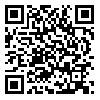Fri, Jul 4, 2025
| فارسی
Volume 22, Issue 3 (Autumn 2020)
Advances in Cognitive Sciences 2020, 22(3): 79-94 |
Back to browse issues page
Download citation:
BibTeX | RIS | EndNote | Medlars | ProCite | Reference Manager | RefWorks
Send citation to:



BibTeX | RIS | EndNote | Medlars | ProCite | Reference Manager | RefWorks
Send citation to:
Khojastebakht1 F, Rasti J, Tavakoli M, Sarrami Foroushani N. Design and validation of Virtual Reality software package with Real images for treatment of attention deficit disorder symptoms. Advances in Cognitive Sciences 2020; 22 (3) :79-94
URL: http://icssjournal.ir/article-1-937-en.html
URL: http://icssjournal.ir/article-1-937-en.html
1- MSc of Biomedical Engineering, Department of Biomedical Engineering, Faculty of Engineering, University of Isfahan, Isfahan, Iran
2- Assistant Professor of Biomedical Engineering, Department of Biomedical Engineering, Faculty of Engineering, University of Isfahan, Isfahan, Iran
3- Assistant Professor of Psychology, Department of Psychology, Faculty of Education and Psychology, University of Isfahan, Isfahan, Iran
4- PhD Student of Psychology, Department of Psychology, Humanistic and Basic Science Faculty, Yazd Science and Art University, Yazd, Iran
2- Assistant Professor of Biomedical Engineering, Department of Biomedical Engineering, Faculty of Engineering, University of Isfahan, Isfahan, Iran
3- Assistant Professor of Psychology, Department of Psychology, Faculty of Education and Psychology, University of Isfahan, Isfahan, Iran
4- PhD Student of Psychology, Department of Psychology, Humanistic and Basic Science Faculty, Yazd Science and Art University, Yazd, Iran
Abstract: (3296 Views)
Introduction: The inability to concentrate on a specific topic in the presence of distracting factors is of evident symptoms of Attention Deficit Disorder (ADD). Controlled simulation of such factors through immersion in real environments by Virtual Reality (VR) technology can be effective to improve attention. The study aims to design and validate a VR-based software package to decrease the effect of distraction factors and improve ADD symptoms.
Methods: The VR-based software package comprises 18 short panoramic footages with pre-determined scenarios, each of which includes the main topic and some irrelevant distracting factors. The intervention procedure includes watching two footages per session and answering the related questions. For content validation, five attention psychotherapists and five VR experts were selected on purpose, and after applying their revisory comments, the results of the validation questionnaires were analyzed to obtain the Cohen's Kappa coefficient. For introductory intervention, the population comprised all female students with ADD in grade six of the elementary school in 2017-18 academic years in Isfahan, Iran. A limited sample of 14 people was selected based on inclusion criteria and randomly assigned to equal experimental and control groups. The intervention was carried out for the experimental group in nine sessions, while the control group was on the waiting list. All subjects' parents completed the SNAP-IV questionnaires before and after the intervention period, and the results were analyzed the using non-parametric Mann–Whitney U test in SPSS-23.
Results: Cohen's Kappa coefficient of 0.83 shows acceptable content validity. The Mann–Whitney U test indicated the effectiveness of VR-based software package on improving attention in students with ADD (F=-3.232, P=0.001).
Conclusion: Simulating real distracting factors in an immersive VR platform can lead to an improvement in attention and reduce ADD symptoms. Moreover, customizing the virtual environment based on the subject’s demands can provide an ideal therapy plan.
Methods: The VR-based software package comprises 18 short panoramic footages with pre-determined scenarios, each of which includes the main topic and some irrelevant distracting factors. The intervention procedure includes watching two footages per session and answering the related questions. For content validation, five attention psychotherapists and five VR experts were selected on purpose, and after applying their revisory comments, the results of the validation questionnaires were analyzed to obtain the Cohen's Kappa coefficient. For introductory intervention, the population comprised all female students with ADD in grade six of the elementary school in 2017-18 academic years in Isfahan, Iran. A limited sample of 14 people was selected based on inclusion criteria and randomly assigned to equal experimental and control groups. The intervention was carried out for the experimental group in nine sessions, while the control group was on the waiting list. All subjects' parents completed the SNAP-IV questionnaires before and after the intervention period, and the results were analyzed the using non-parametric Mann–Whitney U test in SPSS-23.
Results: Cohen's Kappa coefficient of 0.83 shows acceptable content validity. The Mann–Whitney U test indicated the effectiveness of VR-based software package on improving attention in students with ADD (F=-3.232, P=0.001).
Conclusion: Simulating real distracting factors in an immersive VR platform can lead to an improvement in attention and reduce ADD symptoms. Moreover, customizing the virtual environment based on the subject’s demands can provide an ideal therapy plan.
Type of Study: Research |
Received: 2019/05/11 | Accepted: 2020/04/21 | Published: 2020/10/1
Received: 2019/05/11 | Accepted: 2020/04/21 | Published: 2020/10/1
Send email to the article author
| Rights and permissions | |
 |
This work is licensed under a Creative Commons Attribution-NonCommercial 4.0 International License. |






